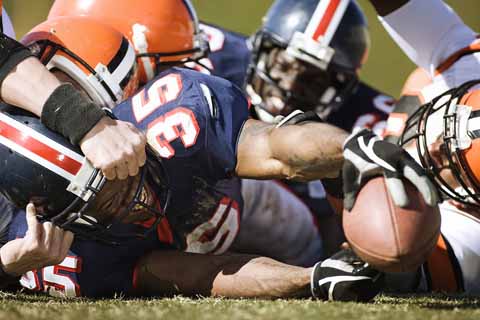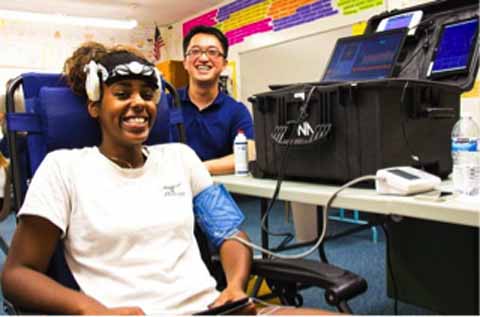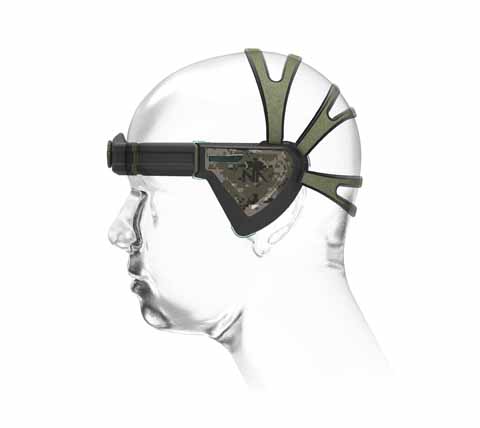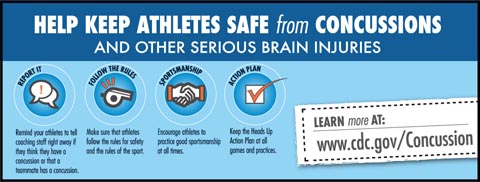Game vs. Brain: New Hope for Detecting Concussions on the Sidelines
May 9, 2016
New studies about the dangers of sports-related concussions seem to come out weekly. With headlines warning of links to long-term cognitive challenges, personality changes, and even suicide, it’s no wonder that some parents are pushing their kids to join the chess club over football and soccer. The risk of serious damage increases with the number and frequency of concussions an athlete receives, so hope lies in the ability to prevent them as well as diagnose them immediately after a blow to the head.

Image Credit: Penn State (CC BY-NC-ND 2.0)
Diagnosing concussions on the field is tricky business, even for the well-trained. The screening is based on common symptoms like impairments in concentration (e.g. unable to recite the months of the year in reverse order), confusion (e.g. not knowing what day it is), and loss of coordination/balance. Some athletes don’t seek help or accurately report their symptoms. The symptoms of a concussion don’t always appear immediately, and can be different for different people. Not all teams have adequate personnel or training to evaluate athletes properly after an injury. Misconceptions abound, like the belief that concussions are always preceded by a loss of consciousness. Clearly, a portable, reliable device that could quickly diagnose a concussion on the sidelines would be a major victory for all athletes.
A new headset being developed by scientists at the company Neural Analytics may provide just such a solution, enabling coaches and athletic trainers to rely on the brain itself to reveal damage, rather than on the reporting and interpretation of a player’s symptoms.
Examining the Brain for Signs of Concussion
There aren’t any really good, objective, yes-or-no tests for concussions, even at the hospital. You can’t just X-ray a brain and see a concussion like you do a broken bone. In many cases patients with head injuries will have brain scans, but these are to check for other complications from the trauma. The most common are CT and MRI scans.
A CT scan takes X-ray images of the skull and brain and layers them to build a kind of 3D image. This is great for seeing skull fractures, swelling, and bleeding. However, patients with concussions alone often have normal CT scans.
An MRI creates an image of the brain based on how atoms in your body respond to radio waves while you lay inside of a large magnetic field. They can provide more detail than CT scans, especially when it comes to small bleeding, bruising, or scarring. However, patients with concussions alone often have normal MRI scans too.
Studies indicate that concussions are not structural injuries, like the ones CT and traditional MRI scans detect. Instead, concussions are physiological injuries—they change how the brain functions. These changes, while not physical injuries per se, are still physical. For example, concussions reduce the amount of blood and oxygen flowing to the brain. In the last few years, scientists have started exploring whether measures of blood flow can be used to diagnose concussions.
This is the focus of work by researchers at Neural Analytics, a spin-off company from the Department of Neurology at the University of California Los Angeles. They suggest that sound waves, specifically ultrasound, could be a useful, cost-effective tool for measuring blood flow in one of the main arteries in the brain and distinguishing between healthy brains and those with concussions.
A New Approach
You may be most familiar with ultrasound in the context of revealing the gender of a baby in utero. In that case, an obstetrician or technician uses a probe to send high frequency sound waves into the body. A part of the sound wave echoes back each time it encounters a new kind of tissue. These echoes are picked up by the transducer, along with the time it took the echo to travel back—which indicates the depth of the tissue. Computer programs translate this information into measurements and grainy “first photos” of unborn children. Ultrasound is similarly used to diagnose issues in other parts of the body—tendons, muscles, and organs, for example.
To measure blood flow, Neural Analytics has created a headset based on something called transcranial Doppler, or TCD. “Transcranial” means “through the skull”, and “Doppler” refers to a special type of ultrasound, called Doppler ultrasound, based on the Doppler effect.

A subject wearing the Neural Analytics headset during testing.
Image Credit: Neural Analytics
If you’ve ever noticed the difference in sound between a wailing ambulance approaching you and racing away from you, you’ve heard the Doppler effect in action. It describes how the frequency of a sound wave changes from your perspective based on whether the sound is moving toward you or away from you (check out this video to hear it in action). If you were to record the siren from your location at an instance in time and you knew the actual frequency the siren emitted, you could mathematically determine how fast the ambulance was traveling, and whether it is moving toward or away from you. Doppler ultrasound applies this same principle to ultrasound waves echoing back to a transducer from moving red blood cells.
TCD is relatively inexpensive and portable, so if it can detect subtle changes in blood flow that tie directly to the presence or absence of a concussion, teams at all levels could have one on hand to scan players immediately after an injury. This would provide important information for the coaches and others involved in the decision of whether the athlete can safely return to the game.
The technique isn’t new. It is currently used in diagnosing hemorrhages, clots, certain blood disorders, and other conditions that affect blood flow in the brain. However, traditionally TCD has not been able to detect the subtle changes in blood flow caused by a concussion. To remedy this, the team at Neural Analytics is working on serious upgrades to the data analysis.
In traditional TCD, the signal picked up by the transducer is used to calculate a set of simple, standard measurements. The Neural Analytics team realized that this analysis was ignoring a lot of subtle, but potentially relevant information about how blood travels through the brain’s arteries. Through a process called machine learning that exposes a computer program to large sets of signals from different groups, the team is identifying a sub-set of features in the previously ignored parts of the signal that are good indicators of injury, according to Robert Hamilton, the Chief Science Officer at Neural Analytics. These indicators could likely be linked with specific physiological causes in future studies involving animals.

A prototype image of a possible design for the headset.
Image Credit: Neural Analytics
Early Results
At a meeting of the American Academy of Neurology earlier this spring, the team presented promising results on its effectiveness. They used the headset to scan 66 high school athletes diagnosed with concussions and a control group of 169 other athletes. Those with concussions were scanned an average of six days after being injured. The headset could tell the difference between a healthy brain and one with a concussion 83% of the time, an increase of 13% over the best of the traditional TCD measurements.
More work is necessary to refine the technique and test its effectiveness in other situations, such as immediately after a head injury has been sustained. However, initial results are promising. There is great need for an objective tool like this that could be inexpensively purchased and relied on to help athletes continue playing when it’s safe, and seek help immediately when there are signs of trouble instead of risking a dangerous second injury.
For more information on preventing, identifying, and recovering from sports-related concussions, visit the Centers for Disease Control and Prevention’s HEADS UP website.

Image Credit: HEADS UP, Centers for Disease Control














